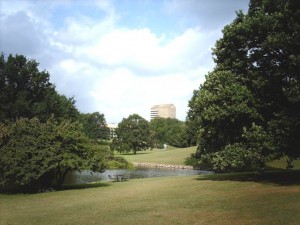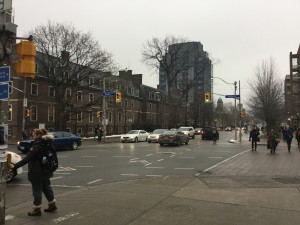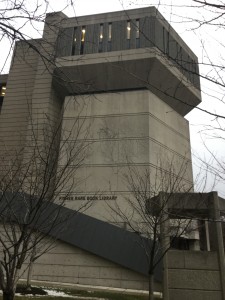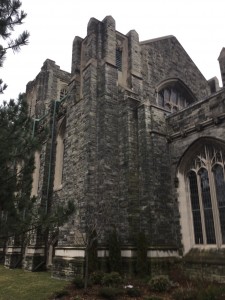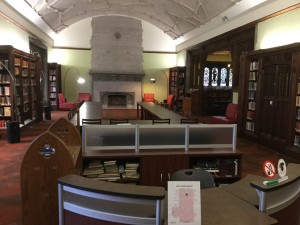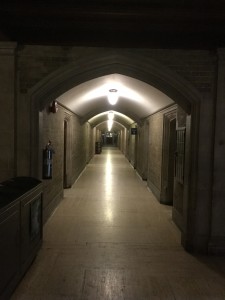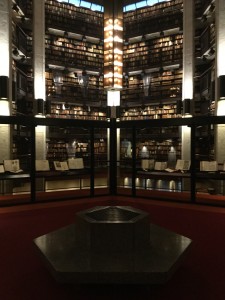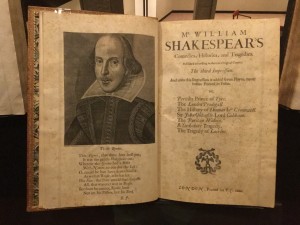Once we had all the recordings completed, we sat down together to listen to what we’d collected and to discuss how we’d use the material. We listened to each of the three sets of five minute recordings for each space, considering how we might intermix noise and silence in an attempt to disorient the listener.
There were two features that struck us about the recordings in each space. The first was that already one could feel disoriented by simply listening to an individual recording. The first space, for example, the Hart House Library, is presumably a quiet area. But one could easily confound the space with a number of locations. In the recording, one hears sounds that are expected of a university library, such as pages turning, whispering voices, and computers typing away. But there are other sounds as well that make identifying the location difficult. A radiator that normally one doesn’t register when walking into the space, for instance, can be heard tapping quite loudly.
The sound of the wooden floor creaking underfoot also disrupted any possibility of silence in the room. When walking close to the library window, the sound of sirens outside easily registered, making it possible for one to imagine the recording was made outdoors.
The second feature that intrigued us about the recordings were the distinct differences between recordings made within a single space, even though the recordings took place just five minutes apart from one another. This was most notable in the Knox College chapel. A normally quiet location – and certainly relatively quiet during the last recording – the chapel was initially (and unexpectedly) filled with the beautiful sound of a piano being played by a student. Two different sections of the same music piece can be heard in the first two recordings, while there is no piano in the third. Completely by accident, we surreptitiously captured the private, impromptu performance for all the world to hear.
Contrary to the differences between recordings, sometimes the audio continued over a longer duration, throughout all three recordings, giving them more unity. This was the case in the Hart House hallways, as we each passed the same busy restaurant; at University College, as we each passed an on-going lecture about the social history of life in Paris, as well as a pair of students conversing in Chinese; or as we each stumbled across the Shakespeare lecture (referenced in a previous blog post). These fragments of both completely different and repeating sections of audio over time inspired us to work around the idea of ghosting a space through audio – walking through a space in present time, while listening to the ghostly voices and sounds of time past.
We weren’t satisfied with simply replaying a single layer of audio, however. In hearing the different recordings from each space, we decided to create several variations for each location. We decided upon the following five variations:
Variation 1: A single layer unedited audio recording from the space;
Variation 2: Multiple layers of audio recording taken over three passes from the same space;
Variation 3: Multiple layers of audio taken from all spaces along the whole walk;
Variation 4: Multiple layers of audio taken from all spaces of the walk, as well audio from spaces not included on the walk;
Variation 5: Following the walk without any recorded audio.
In addition to playing with disorienting the audience and conjuring ghostly narratives of past lives in the mind of the listener, we also aimed to heighten the listener’s awareness of sound in a space with the variations. Normally, one isn’t particularly aware of the audio of a location, and even less so when a space or walk is visited or repeated regularly. However, it is precisely through repetition – in listening to the small differences in detail between each variation – that we hope to increase the listener’s awareness of the audio in the space as they listen to recordings, and perhaps even after, as the listener revisits a space without any audio recording whatsoever.
In the following weeks, we will look at the audio variations created for different spaces along the walk, and look at some of the differences in detail between them.
